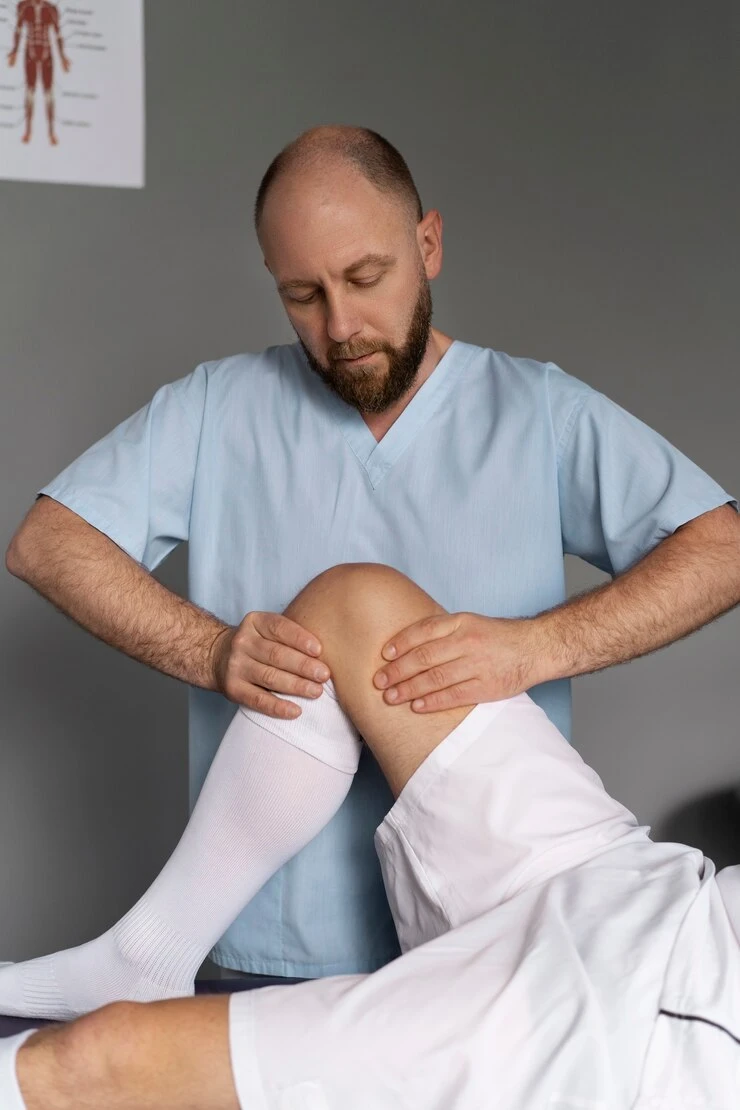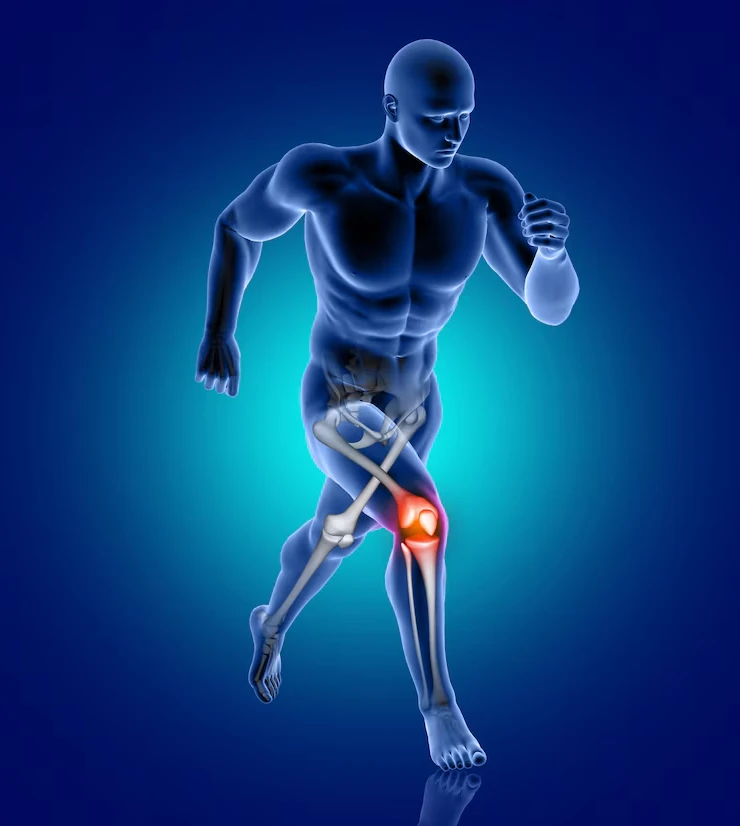
Knee Replacement Surgery at Kush Orthopedic & Health Centre
Are you facing a knee surgery but worried about the knee replacement surgery cost in Ghaziabad? If yes! This is the right blog for you.
Let’s cover a brief introduction to understand knee replacement before explaining why knee replacement surgery is crucial. In the knee replacement surgery procedure, plastic and metal parts are used to fill the gap of the bone’s ends that form the knee joint. However, this knee surgery is considered for you if you are dealing with extreme arthritis or an unbearable knee injury.
Moreover, numerous types of arthritis might impact the knee joint. Osteoarthritis is a degenerative joint disease that affects mostly middle-aged (40-55) and more senior adults (60-80). Likewise, it might cause the breakdown of adjacent bone and joint cartilage in the knees. It is only one of the arthritis we are talking about. Therefore, before it causes more severe issues for your health, ensure to opt for knee replacement surgery at the appropriate knee replacement cost in Ghaziabad.
At Kush Orthopedic & Health Centre, we understand the effect of such situations on a patient’s day-to-day life and are committed to improving their quality of life. Our team of skilled and professional surgeons provides compassionate care and cutting-edge surgical solutions according to your condition, needs, and requirements. Furthermore, in this blog, we will discuss all the parameters that come under knee replacement. So, let’s get started!
Brief About Knee Replacement Surgery
The knee is a complicated joint that joins the bones of the legs. It is also known as knee arthroplasty. Likewise, it is performed when the knee bones and cartilage are immensely worn down by arthritis or any other kind of injury. The replacement components are usually plastic and metal. If we talk about conventional medication, injections, therapy, or anything else that did not reduce the pain, you need to think about knee replacement surgery before it’s too late.
What are the Types of Knee Replacement Surgery?
If you are searching for the best health centre near me, ensure to know the root type of your surgery. There are multiple types of knee replacement surgeries are available based on the extent of process and the particular requirements of the patient. Let’s discuss one-by-one.
1. Total Knee Replacement
Total knee replacement surgery involves replacing the entire injured knee joint with a false prosthesis. Thus, this metal prosthesis includes aluminum and titanium metal elements for the femur, tibia, and a plastic spacer in between. Likewise, it allows smooth movement without causing any symptoms of pain.
2. Partial Knee Replacement (PKR)
This surgical procedure is performed when only one section of the knee is impacted by arthritis. In partial knee replacement, only the injured compartment of the knee joint is replaced with a prosthetic implant. It helps in preserving healthy bones and ligaments without causing any other issues in the knee.
3. Bilateral Knee Replacement
It is procedure in which both knees replaces in single surgery. Bilateral knee replacement normnally performed for patients with critical arthritis or damage in both knees. Hence, it allows them to undergo a surgery and recovery time instead of two sperate knee surgery procedure.
4. Complex or Revision Knee Replacement
Complex or revision knee replacement surgery is performed when the prior knee replacement surgery failed or needs correction. Revision or complicated knee surgery involves removing the prosthesis which is still their and replacing it with a new one to highlight instability or complications.
5. Minimally Invasive Knee Replacement
In this particular approach, tiny incisions are compared to traditional knee replacement surgery. It aims at reducing muscle and tissue disruption. Similarly, it potentially leads to a few days hospital stay, prevent scarring, and faster reciver period.

Imperative Reasons for Knee Replacement Surgery
The knee replacement surgery is suggested by the doctor when other treatments, like medication, physiotherapy, or lifestyle improvement, have failed to provide the relief you need from your knee pain or restore mobility. Some situations might lead to replacement surgery that includes:
1. Osteoarthritis
It is a common degenerative joint disease, which orccur when the protective cartilage that secure the bones in the knee joints wears away. Thus, it leads to pain, restricted mobility, and stiffness.
2. Post-traumatic Arthritis
It is a form of arthritis that might occur after a knee injury, like a ligament tear or fracture. It is one of the most crucial reasons to visit the best orthopedic doctor in Ghaziabad. An expert doctor will help you prevent the swelling, pain, and immobility that happens with arthritis.
3. Rheumatoid Arthritis
It is an autoimmune situation causing damage and inflammation to the joints. Due to this, you have to deal with unbearable pain, swelling, and stiffness, which makes it difficult to do daily activities.

Risk Factors of Knee Replacement
Here are some risk factors that you should know to prevent thinking about the knee replacement surgery cost in Ghaziabad.
- Age is one of the common risk factors that you have to deal with. If you are at a delicate age of mid to senior citizen, even a minor wear and tear on the knee joints can tend to increase with time.
- The primary contributor to the requirement of knee replacement surgery is osteoarthritis. It is caused by the injury that occurs knee joint’s cartilage, which leads to stiffness in muscles and severe pain.
- If you are dealing with an autoimmune disorder, it’s time to take it very seriously. It affects the joints, which might need knee replacement surgery.
- Knee replacement factors mainly occur in women aged over 50. It is because of the hormonal and anatomical differences that increase the chances of knee replacement surgery.
- Genetic factor plays an imperative role in knee replacement surgery. It might predispose you to situations like osteoarthritis.
Procedure of Knee Replacement that You Must Know
The day of your surgery, you’ll have anesthesia that will numb your body and ensure that you won’t feel pain. An anesthesiologist will administer general anesthesia to sedate you during your surgery or regional anesthesia to numb you from your waist down.
During knee replacement, your surgeon will:
- Take out the damaged cartilage and bone.
- Insert the prosthetic knee joint.
- Place a plastic spacer that provides you comfortable and smooth cushion for your cartilage that was harmed during the surgical process.
- Redefine your patella (kneecap) to accommodate the new prosthetic knee joint (if necessary).

Recovering Time from a Knee Replacement Surgery
It will take about one year to completely heal after a knee replacement surgery. However, during this process, you will likely be able to do normal exercises or activities in six weeks.
- Your recovery will depend on a number of things, such as:
- Your level of activity before surgery.
- Your age.
- Your other medical conditions.
Your surgeon will provide you with an individualised recovery plan, but in general, you should:
1. Ice Your Knee
To recover rapidly, ensure to ice your knee multiple times a day for 20 minutes at a time to reduce pain and swelling.
2. Elevate Your Knee
While lying on your back, ensure to keep your knees higher than your heart in the upper direction as much as possible to bear the knee pain. You can rest it on cushions or pillows when you’re lying down or on a footstool if you’re sitting in a chair.
3. Keep Your Incision Clean and Covered
During the recovery process, ensure to follow the surgeon’s incision instructions. Ask your surgeon when to change the dressing on your incision and when you may safely shower or bathe.
4. Home Exercises
Your surgeon will provide you with exercises to perform as soon as possible after your operation. They’ll demonstrate how to do movements and exercises to make the muscles around your knee stronger and avoid stiffness. Perform your exercises as frequently as your surgeon advises. Professional assistance will help your recovery and ensure your joints function like before.
5. Physical Therapy
You will see a physical therapist for as long as a few months following your surgery. They will assist you in beginning to move safely, such as bending your knee and walking.
Wrapping It Up!
We hope this blog provides you with the major aspects covering every section of knee replacement surgery. We understand if you are worried about the knee replacement cost. However, at Kush Orthopedic & Health Centre, we offer a patient-centric environment and ensure that price is never the reason for your severe health condition. We are here to provide end-to-end medical assistance under one roof so that you don’t have to go to multiple places just to get your surgery done. So, do not wait any further! Call us today or book your appointment and let us handle your health condition.
Frequently Asked Questions
After six days of the surgery, we will recommend that you continue to do regular activities. It might take four months to subside the pain and up to one year for full recovery.
There is a severe amount of pain that occurs from knee replacement surgery. However, you will be provided with pain relief medication so you can heal gently and comfortably. In case the pain becomes unbearable, you must consult a doctor immediately.
Yes! It is worth it if you are experiencing pain and discomfort for a very long time with no pain relief from traditional medications and therapy.
